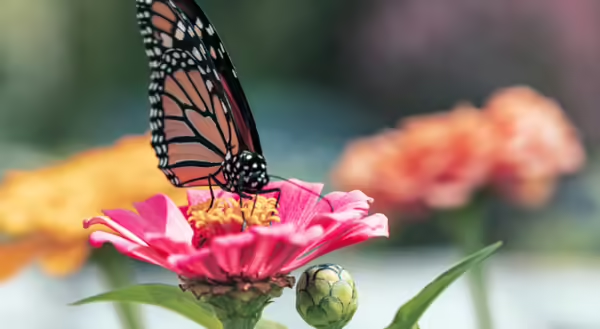
Thank a pollinator for that warm cup of coffee in your hands, or for that chocolate sundae you indulged in the other day. National Pollinator Week is June 21-27; celebrate pollinators and support their health this year. Did you know that that pollinators like bees and butterflies, provide 1 out of 3 bites of food we eat? Over 80% of flowering plants are pollinated by these small, but busy animals.
Just like us, and all animals, pollinators need food, shelter, and water to survive. Gather your family or friends and have a party for the pollinators by creating these simple DIY projects to add to your backyard pollinator-friendly habitat.
Butterflies need water to survive but do not visit large stands of water to drink. They visit damp soil or mud, this is known as puddling. These shallow water sources provide the necessary salt and amino acids butterflies need to survive. Create a butterfly puddler with a shallow dish, sand, soil, water, and flat stones. Fill the container with sand, level it off, and create an indention in the center to collect water. Lightly sprinkle soil over the sand to provide nutrition. Add water to the container and place it in your garden amongst your plants. Replace the water in the container as needed. Flat stones can also be placed on top of the sand for butterflies to land.
For additional nectar in the garden or to provide a source when not many plants are blooming, make a feeder for the butterflies. Start by making a nectar formula (same as one for hummingbirds!) by boiling 1 cup of water and ¼ cup granulated sugar until dissolved, and then cool completely. Soak a sponge in the nectar mix until it is well-absorbed, and lay on a flat dish in the garden. Sponges can also be spritzed with nectar formula and hung in the garden. Butterflies also love fruit, sipping the fresh juice for a refreshing treat. Provide slices of ripe citrus, strawberries, peaches, or apples and watch them flock to it.
Mason bees are some of the best pollinators, collecting pollen on their entire body and flying from flower to flower. They are solitary bees, living on their own, and finding existing tunnels to nest in. Look up plans online to create a Mason bee house. Just remember that tubes must be at least 6 inches long to be useful nesting material. Place the house in a protected location (east or south-facing) at eye level. Replace used tubes in the spring after the bees have emerged.
Contribute to science through pollinator-related community science projects, a form of research that provides everyone, regardless of their background, an opportunity to contribute meaningful data to further our scientific understanding of key issues. Some popular projects include BeeSpotter, iPollinate, Monarch Watch, and the Great Sunflower Project.
Main Photo Credit: Butterfly on a pollinator flower by Amy Lynn Grover on Unsplash
ABOUT THE AUTHOR: Brittnay Haag is a Horticulture Educator with University of Illinois Extension, serving Livingston, McLean, and Woodford Counties. Her work focuses on youth horticulture education, specifically through school gardens and Jr. Master Gardener programs. Brittnay provides leadership for three county Master Gardener programs, and is responsible for developing community programs and providing expertise in horticulture and environmental sciences.